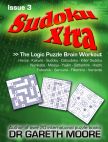|
How to play Kakuro
Looking for help with the dokakuro.com Kakuro player? Click here.
| In Kakuro you must place the digits 1 to 9 into a grid of squares so that each horizontal or vertical run of white squares adds up to the clue printed either to the left of or above the run. Numbers below a diagonal line give the total of the white squares below; numbers to the right of a diagonal line give the total of the white squares to the right.
No digit can be repeated within any single run. Runs end when you reach a non-white square.
Every puzzle has a single unique solution and can be solved purely by logic - no guessing is required.
Play a grid right now in our online player
| | ![[Example Kakuro Grid]](eg1.gif) |
How to solve?
The secret of solving the puzzle is to use the constraint that no digit can be repeated in a single run. For example, if the clue '4' is given for a run of two squares then the two digits that make it up must be '1' and '3'. They cannot be '2' and '2' because this would repeat a digit. '0' is never allowed, so '4' and '0' is not an option. The solution must contain '1' in one square and '3' in the other.
The clue '3' using two squares can only be solved with '1' and '2'. If these squares overlap those from the clue '4' then the square that overlaps both clues must be solved with the digit '1', because this is the only number that will solve both clues simultaneously.
A look at the list of valid number combinations for given clue totals and lengths might be useful. Clues with only one possible solution are always worth looking at first. Move on to those with the least number of solutions next, and so on.
There's also an illustrated example puzzle to demonstrate how the first few moves could be made.
Good luck!
| 



![[Example Kakuro Grid]](eg1.gif)